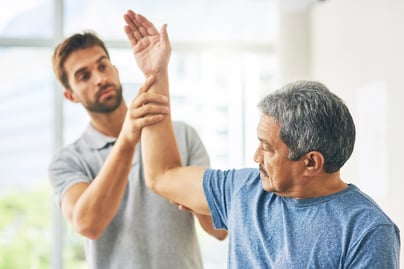 Arthritis is an increasingly common condition that refers to 100 different types of diseases, affects all age groups and affects 1 in 4 adults, equating to 80 million people in the United States. The most common form seen is osteoarthritis or degenerative joint disease and we see these conditions impacting the lives of residents in the senior living communities we serve every day. Studies have shown that half of adults living with this condition do not believe anything can be done, but in fact there are many strategies that can be employed in daily living and in exercise that can provide a better quality of life for those affected.
Arthritis is an increasingly common condition that refers to 100 different types of diseases, affects all age groups and affects 1 in 4 adults, equating to 80 million people in the United States. The most common form seen is osteoarthritis or degenerative joint disease and we see these conditions impacting the lives of residents in the senior living communities we serve every day. Studies have shown that half of adults living with this condition do not believe anything can be done, but in fact there are many strategies that can be employed in daily living and in exercise that can provide a better quality of life for those affected.
Everything starts with your feet so investing in shoes with adequate cushioning and stabilization should be a top priority. Sneakers with extra cushioning should be your choice for most athletic activities, New Balance are great for different width selection and are very durable. Hoka provides excellent cushioning and a ‘rocker’ shaped sole for easier propulsion. Some trial and error is required to find a brand and style that will work best for each individual. Ensuring you are at your healthiest weight will also relieve stress on the joints and associated pain. Speaking of pain, use the 2-hour rule which is if a joint is still hurting from an activity after that duration of time it is a sign that you are most likely overexerting yourself. Next, learn how to move with efficiency and purpose using the best posture and techniques possible. That means reducing range of motion on movements that cause sharp pain and avoid exercises with heavy heel strikes like running or stairs. Low impact is always better, exercising in water, exploring yoga and tai chi and choosing an elliptical vs a treadmill are all savvy decisions.
Another important factor to note is exercising with joint replacements which have general and specific guidelines depending on the joint that was replaced. A general rule is to decrease the range of motion and speed of movement for all replacements as well as avoiding contact sports. Total hip replacements should avoid flexion greater than 90 degrees or 70 degrees with a history of dislocation and crossing the midline of the body in the front or back. Total knees should look out for rotational stress and begin with closed chain work such as a bicycle before progressing to open chain exercises with heel and toe strikes such as pickleball. Total shoulder replacements should avoid contact sports like basketball, heavy, repetitive lifting and chopping motions.
A rest day in between every bout of exercise is recommended with 3 days a week being a great goal for most exercisers. Respecting pain and prioritizing recovery are essential for adherence as well as adapting extra rest days when your body is calling for a long, less active weekend.
Finally, rest and relaxation are essential to managing arthritis with flexibility done at the end of sessions to ensure adequate blood flow in the areas being stretched. In addition, meditation and guided imagery are helpful in focusing on areas that are tense and can be relaxed through isometric contraction and relaxation such as Jacobson’s progressive technique.
As you can see, there are numerous considerations to improving or maintaining joint health and our qualified fitness staff in senior living communities across the US are developing customized exercise plans helping residents move more with less pain.

